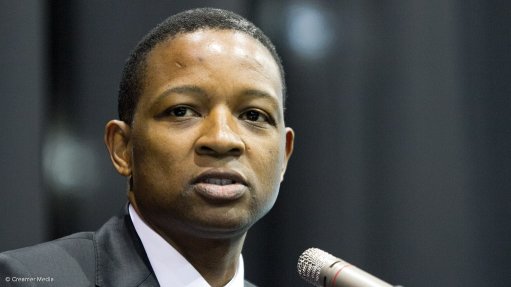
TPT CEO Karl Socikwa
Photo by: Duane Daws
Transnet Port Terminals (TPT) has improved efficiencies and significantly enhanced port throughput, thereby positively impacting on South Africa’s economic growth, CEO Karl Socikwa told delegates at the African Ports Evolution Conference, in Durban.
The conference, now in its fourth year, was aimed at addressing bottlenecks and improving Africa’s competitiveness, with delegates including representatives from port authorities and terminal operators in Nigeria, Kenya, Ghana, Namibia, Tunisia, Angola, Mauritius and Mozambique.
Socikwa noted that efficiency and capacity generation went hand-in-hand with the wider Transnet Market Demand Strategy (MDS) that would see R340-billion to R380-billion invested in the rehabilitation of infrastructure over the next ten years.
Through investing in “the softer aspects” or assets, TPT was looking at how it could better use and leverage existing technology and technological advancements.
“For example, we looked at automation and we could see the strides being made in terms of deploying automated terminals in Europe and other parts of the world. In South Africa, because of the high unemployment rate, we cannot consider full automation. But we can look at how we can leverage technology to ensure we have the same, if not more, gains, while also reskilling and upskilling our people,” he noted.
He cited the Integrated Port Management System introduced by the Transnet National Port Authority as an example. Technology that would alert TPT to maintenance issues for cranes ahead of breakdowns was another example. Making assets “technology smart” facilitated predictive planning and, through intervening earlier, delays could be eliminated.
Socikwa said the introduction of the NAVIS a few years ago had almost entirely eliminated document processing, allowing for better planning and ensuring TPT had a broad user base comprising trucking and shipping companies and cargo owners that had access to the system and full line of sight. This had created time and cost savings, which could be passed on to various users.
He added that TPT was also looking at value-chain coordination and optimisation. “We have looked at a number of priority commodities and created multi-operating division teams that work in different corridors.
“For example, the iron-ore corridor, for which I’m responsible, looks at the flows from the Northern Cape all the way to Saldanha Bay. We look at the entire corridor and how to eliminate pockets of inefficiency.”
Pointing out that more than 60-million tons were exported through the Port of Saldanha Bay, he said that optimising efficiencies at both the iron-ore terminal and the multipurpose terminal could see TPT handle an additional two-million tons annually.
TPT had piloted a similar approach with the magnetite and chrome corridor in Richards Bay about 18 months ago. This delivered significant benefits, including an increase in capacity of between 15% and 18%.
Until then, capacity had been dominated by two big players. The increase in capacity enabled TPT to accommodate both and take on a third customer without spending on additional infrastructure.
Going forward, TPT would also be able to create capacity for more customers.
Socikwa said improved efficiencies would enable ongoing investment in infrastructure, despite the current financial downturn.
Referring to the 2008/9 global recession, he said the Transnet group had scaled back on investment in assets and infrastructure. “That caught up with us once the cycle ended and we don’t want to find ourselves in the same situation.”
Transnet was implementing a countercyclical investment programme, which Socikwa admitted was “a bit nerve-racking”.
However, investing in smarter ways of doing things and softer assets would enable Transnet to realise additional capacity and introduce more customers onto the corridors and channels, thereby generating the volumes needed to justify investment in infrastructure.
He said TPT was also making a concerted effort to move commodity flows from road to rail. “Trucking is ideal for local distribution. Between Durban and Gauteng, more rail capacity can be made available and the more we utilise this, the better we will be as a country. That is one of the big thrusts.”